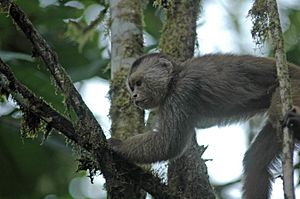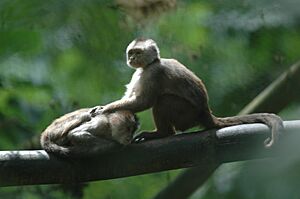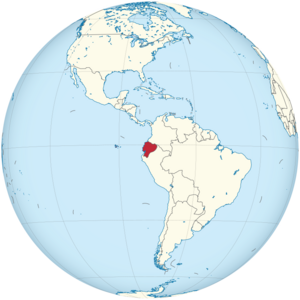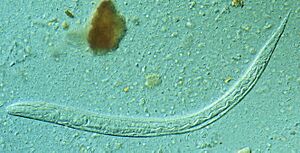Ecuadorian capuchin facts for kids
Quick facts for kids Ecuadorian capuchin |
|
|---|---|
 |
|
| Conservation status | |
| Scientific classification | |
| Genus: |
Cebus
|
| Species: |
aequatorialis
|
The Ecuadorian capuchin (Cebus aequatorialis) is a type of gracile capuchin monkey. It belongs to the Cebidae family. This monkey was once thought to be a smaller group (a subspecies) of the white-fronted capuchin. But in 2013, scientists decided it was its own separate species.
Ecuadorian capuchins look a bit different from other capuchins, especially in their colors. They are also found in a specific area. This area stretches from western lowland Ecuador to northwestern Peru. Sadly, these monkeys are now considered critically endangered. This means they are at a very high risk of disappearing forever. Their numbers have dropped quickly because of human activities.
Contents
Amazing Monkey Behavior
How Capuchins Live Together
Ecuadorian capuchins usually live in groups. These groups have both male and female monkeys. They also have young monkeys. A typical group has about 13 monkeys, but it can be anywhere from 5 to 20. Studies show that there are often more female capuchins than males. There are also many young monkeys compared to adult females.
New Ways of Living
Scientists have seen Ecuadorian capuchins doing new things. They were found in parts of Ecuador where there were not many tall trees. This is unusual because these monkeys usually prefer places with lots of tall trees. A study showed that in fall and winter, trees lose their leaves. Fruits also fall to the ground. This makes the capuchins come down to the ground to find food. This is called foraging.
Another reason for this new behavior is that there might be less food in the trees. Or, their homes might be broken up into smaller pieces. This is called habitat fragmentation. When their homes change, these capuchins have to change their behavior. They do this to survive.
What Do Capuchins Eat?
The Ecuadorian capuchin eats many different things. Their diet includes insects and fruits. They also eat other small creatures without backbones, called invertebrates. They are known to eat the soft parts of bromeliad leaves. These plants grow on other plants or trees. But the most important foods for them are fruits and invertebrates.
Where Capuchins Live
Ecuadorian capuchins need certain things in their home. The most important thing is lots of tree cover. They prefer areas where more than 25% of the land is covered by trees. They also like areas with deciduous trees (which lose leaves) or evergreen trees. They can also live in areas where forests are mixed with farms. They prefer mild temperatures and not too much rain. They also need places where not many people live.
One study found that an Ecuadorian capuchin needs about 500 hectares (about 1,235 acres) of land. This is for them to find food and move around. Their movement has been limited by deforestation (cutting down trees). It is also limited by their homes being broken up. Because of this, their living area has shrunk. It used to be from western Ecuador to northwestern Peru. Now, it is much smaller.
Scientists say that these capuchins are hard to find. This means there are not many of them left. This makes them a very high priority for conservation. Over 90% of their original home has been lost. Their homes are threatened by habitat fragmentation and deforestation. People also cause problems. Farmers burn bushes, animals graze on their land, and there is illegal mining and logging.
Broken Homes: Habitat Fragmentation
Habitat fragmentation is a big problem for monkeys. It makes it hard for them to move around. They have to use more energy to find food. It can also lead to inbreeding. This means monkeys that are too closely related have babies. This can make their groups less healthy. Over 98% of the main forests in western Ecuador are gone. The rest are broken into small pieces. These small pieces are at risk of being destroyed too.
Ecuadorian capuchins need large tropical dry forests. When their homes are broken up, it is harder for them to find food. There is also less space for them to move. To help with this, a special path was created. It is called the Three Forest Conservation Corridor. This path helps connect different forest pieces. Studies show that capuchins are using this path. This means similar efforts can help them survive.
Protecting the Capuchins
The forests in Ecuador and Peru are disappearing fast. Only about 4% of the original forest is left. Scientists have found four important areas that need to be protected. These areas are crucial for the survival of the Ecuadorian capuchin.
These important areas include:
- The Chongon-Colonche hills near the coast of south-central Ecuador.
- The northern coast of the Manabí province in Ecuador.
- The foothills of the Andes Mountains in southern Ecuador.
- The Tumbes and Piura regions of northern Peru.
Scientists believe about 5,208 square kilometers (about 2,011 square miles) of good habitat should be protected. This would help the capuchins and other animals. The most important area to protect is along the Chongón-Colonche range. This area has more continuous and undisturbed forest. It also has some protection already, which makes conservation efforts more likely to succeed.
Capuchins and People
People and capuchins have a long history. Humans have kept capuchins in captivity, like zoos. This is because capuchins are friendly and clever. But there is also a negative side. Ecuadorian capuchins are often taken from their homes and sold illegally. This is called animal trafficking. This stops them from having babies in the wild. It also harms their natural groups.
Farmers sometimes have problems with capuchins. The monkeys will forage for food in their crops. They often eat corn, bananas, plantains, and cacao. This can cause conflict between the monkeys and farmers.
Health and Human Contact
Scientists have studied how human contact affects capuchins' health. They looked at monkeys in the wild and those kept by humans. They found that monkeys who spent more time near humans often spent more time on the ground. Capuchins usually live in trees. But spending more time on the ground can make them more likely to get sick. This is because some tiny living things that cause sickness can be found on the ground.
One study showed that monkeys drinking from a creek had more health problems. This creek was near a village and had human waste in it. This shows that when humans and monkeys interact closely, it can sometimes lead to health issues for the monkeys.





